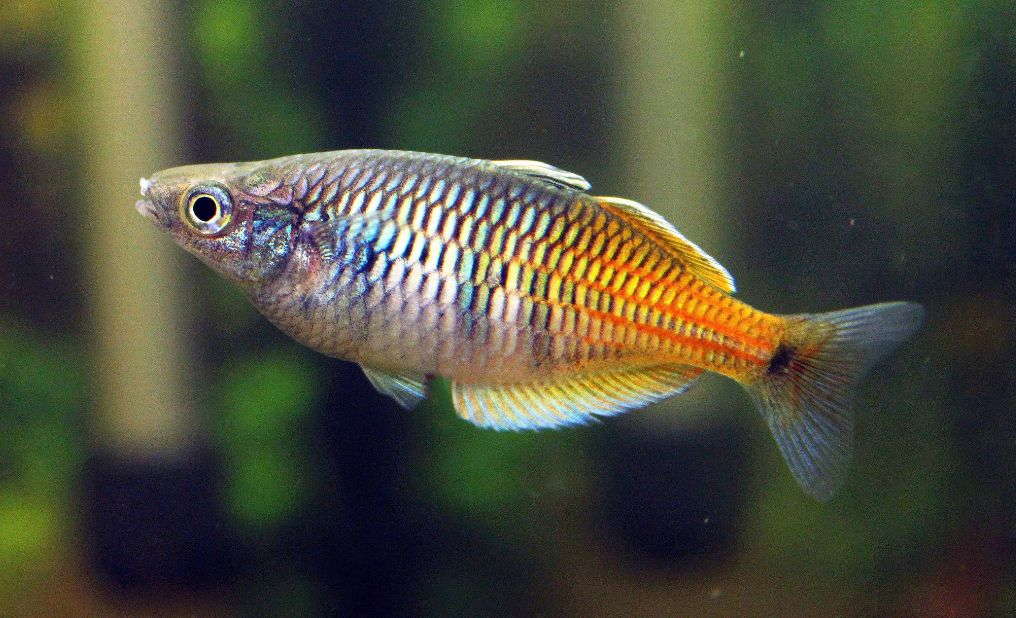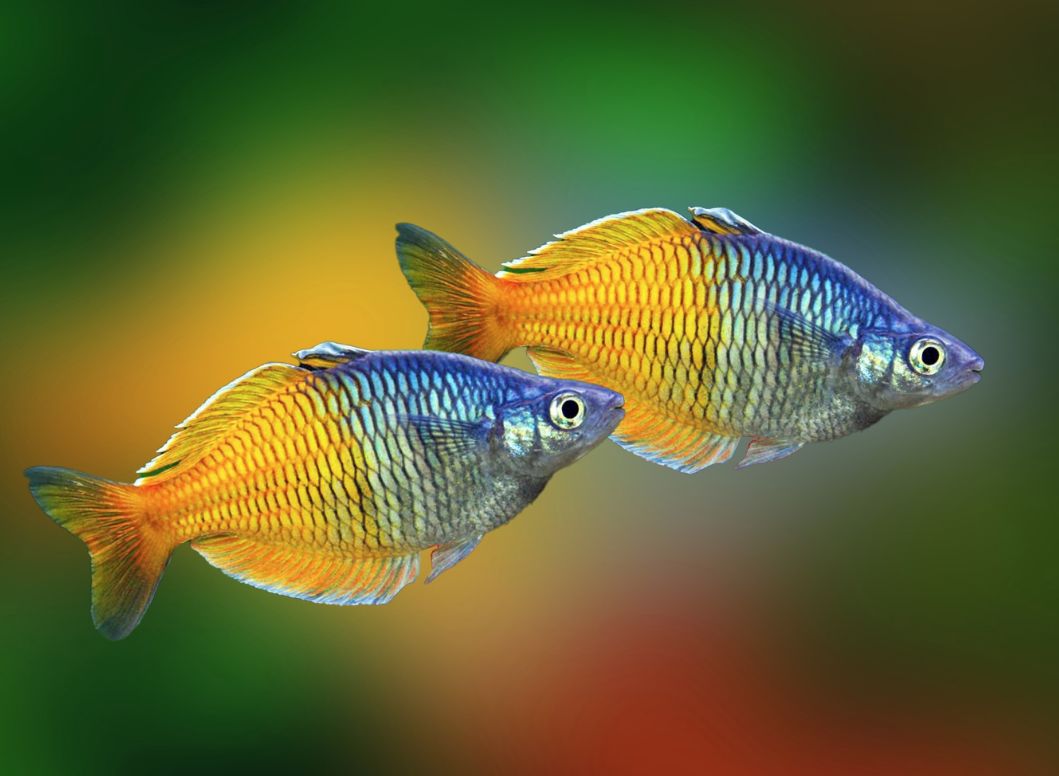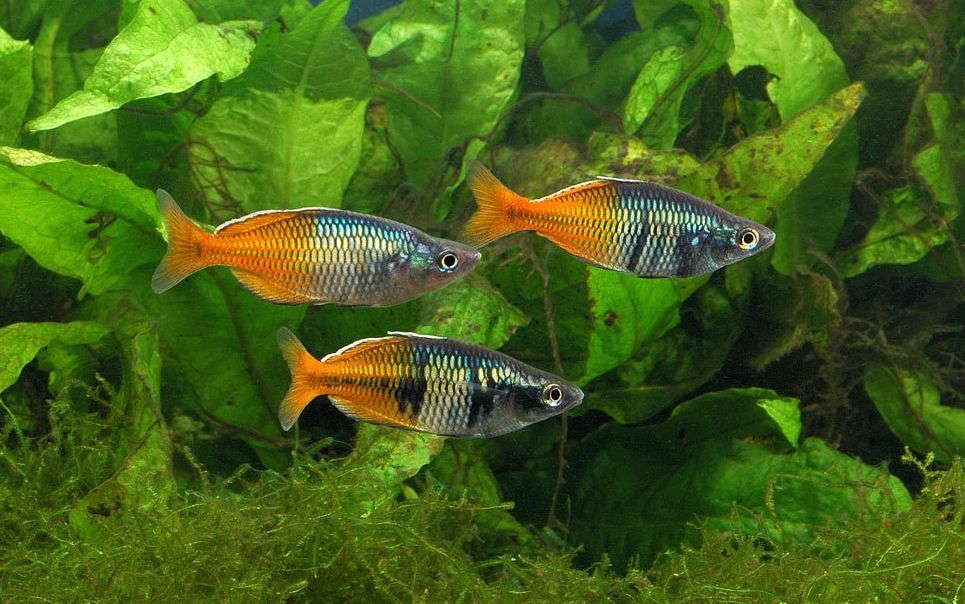The boesemani rainbowfish, known for its stunningly vibrant colors, is a prized addition to any freshwater aquarium. Native to the lush waters of New Guinea, this species dazzles with its bright hues and lively movements. Renowned for its active and schooling nature, the boesemani rainbowfish thrives in a well-planned tank setup. However, due to its specific care requirements and sensitivity, it is best suited for experienced aquarists. Beginners might find its needs challenging to meet, particularly in maintaining the right water conditions and providing ample space for its schooling behavior.

Contents
Habitat in the wild
The boesemani rainbowfish (Melanotaenia boesemani), a member of the Melanotaeniidae family, is named in honor of Dutch ichthyologist Marinus Boeseman, who first described this vibrant species in the 1960s.
Native to the western part of New Guinea, now part of Indonesia, this fish is primarily found in the Ayamaru Lakes region on the Vogelkop Peninsula, formerly known as Irian Jaya. Today, it is known to inhabit just three lakes: Ajamaru, Hain, and Aitinjo.
In the wild, the boesemani rainbowfish thrives in shallow waters rich with dense aquatic vegetation. It often seeks shelter among the plants, where it feeds on both vegetation and small insects. The natural water conditions in its habitat are typically clear, with a slightly acidic to neutral pH ranging from 6.5 to 7.5. The temperature usually falls between 75°F and 82°F (24°C to 28°C), creating an ideal environment for this colorful species.
Description
Body and color
This boesemani rainbowfish has tall, flattened, ellipsoid-shaped body. Its dorsal consists of two parts: small one and elongated one. The anal fin is symmetrical to the elongated part of the dorsal. The tail fin is forked, the head is narrow with large eyes. The body coloring is quite unusual – its head and the part of the body behind it is light blue, which transforms into yellow-orange color starting from the middle of the body to its tail. The males are more colorful than the females, displaying bright hues of blue, purple, orange, and yellow along their body. The colors intensify and become more prominent during courtship and breeding.
Size
The Melanotaenia boesemani typically grows to a length of about 4-5 inches (10-13 cm). Males generally reach a slightly larger size than females. Given their eventual size, it’s crucial to provide ample space in the aquarium to accommodate their active nature and schooling behavior. Proper tank size is essential for ensuring their well-being and allowing them to thrive in a healthy environment.
Lifespan
Boesemani rainbowfish typically have a lifespan of around 5 to 8 years in captivity when provided with proper care. However, it’s important to note that individual lifespans can vary depending on various factors, including water quality, diet, genetics, and overall tank conditions.
| Characteristic | Description |
|---|---|
| Scientific Name | Melanotaenia boesemani |
| Common Name | Boesemani Rainbowfish |
| Native Habitat | Ayamaru Lakes region, New Guinea |
| Size | Up to 4-5 inches (10-13 cm) in length |
| Lifespan | Typically 5-8 years in captivity |
| Colors | Males: Vibrant hues of blue, purple, orange, and yellow |
| Females: Less vibrant, silver-gray with hints of color | |
| Temperament | Generally peaceful and non-aggressive |
| Water Parameters | Temperature: 75-82°F (24-28°C), pH: 6.5-7.5 |
| Diet | Omnivorous, accepts high-quality flakes, pellets, and live/frozen foods |
| Tank Size | Minimum 30 gallons (114 liters) for a small group |
| Tank Setup | Dense vegetation, rocks, and driftwood for hiding spots |
| Compatibility | Peaceful community fish, prefers similar-sized tankmates |
| Breeding | Egg-layers, require a separate breeding tank with plants |
| Conservation Status | Not currently listed as endangered or threatened |

Difficulties in keeping
The boesemani rainbowfish is quite demanding when it comes to its feeding and environmental conditions. It requires consistently stable water parameters and high-quality food to thrive. This species is sensitive to fluctuations in water quality, making it essential to maintain a well-balanced and clean aquarium environment. Due to these requirements, the boesemani rainbowfish is not ideal for beginner aquarists. Success with this fish necessitates experience in managing water conditions and providing a proper diet, which can be challenging for those new to fishkeeping.
Care and keeping in a tank
Tank size
The boesemani rainbowfish thrives in the company of its own kind, so it’s best to keep them in a school of at least 6-8 individuals. This grouping helps promote their natural behavior, reduces stress, and enhances their overall well-being. In a group, these fish display their most vibrant colors and engaging social interactions.
An elongated and spacious tank is ideal for accommodating a school of boesemani rainbowfish. As a general guideline, a tank of at least 30 gallons (114 liters) is recommended for a small group. This size provides ample swimming space and minimizes territorial disputes.
When adding new fish to the tank, do so gradually to allow the established group to adjust and establish a hierarchy with minimal aggression. Introducing multiple new individuals at once or adding a few over time can help. Additionally, maintaining a balanced male-to-female ratio is crucial to reducing male aggression and ensuring harmonious social interactions. Observing the fish’s social behavior and adjusting as needed will help create a thriving community.
Tank decor
The boesemani rainbowfish feels comfortable in tanks with large number of tank plants, but at that they should have plant free areas for the fish to swim. Sandy bottom, lots of plants and snags – this is a biotope that resembles New Guinea waters.
As for the tank plants, choose small leaved ones and put them along the tank perimeter to leave the area to swim. To prevent the fish jumping out of the tank, the latter should have a lid. Intensive filtration and aeration, proper lighting as well as weekly renew of 1/3 of tank water is a must.
Water parameters
The boesemani rainbowfish is quite sensitive to water quality, particularly to ammonia and nitrate levels. To ensure their health and vibrant coloration, it’s crucial to maintain stable water parameters and use an external filter. These fish thrive in a tank with good water flow, so it’s beneficial to keep the flow rate consistent rather than reducing it.
Here are the optimal tank water parameters for boesemani rainbowfish:
- Temperature: 75-82°F (24-28°C)
- pH: 6.5-7.5
- Hardness: 8-25 dGH

Diet
The boesemani rainbowfish is an omnivorous species that enjoys a varied diet. It’s not particularly demanding regarding the type of food, readily accepting artificial, live, and frozen options. However, the quality and composition of their food significantly affect their coloration. To maintain vibrant colors, it’s best to choose high-quality food from reputable brands.
A balanced diet should include high-quality flakes or pellets specifically formulated for tropical fish, which provide essential proteins, vitamins, and minerals. Additionally, incorporating live or frozen foods into their diet is beneficial. Offer small portions of live or frozen foods such as brine shrimp, daphnia, bloodworms, or mosquito larvae. These foods closely mimic their natural diet and are rich in proteins.
Vegetable components should also be included to ensure a well-rounded diet. Provide blanched vegetables like spinach, peas, or zucchini. Cut these into small pieces or puree them to make them easier for the fish to consume. Regularly offering these vegetables, along with live foods at least once a week, helps maintain the health and vibrant colors of your boesemani rainbowfish.
Tank mates
This is a peaceful and active species that gets on perfectly well with other fishes of the same size and temper, capable of living at the same tank conditions. They are generally peaceful fish that can coexist with a variety of tank mates in a community aquarium. Choose tank mates that are of similar size or larger than the boesemani rainbowfish. This helps prevent the Rainbowfish from being harassed or potentially becoming prey to larger, more aggressive fish.
Boesemani Rainbowfish are active swimmers, so it’s best to choose tank mates that are similarly active and occupy different areas of the water column. This helps reduce competition for swimming space and minimizes potential conflicts.
Some suitable tank mates:
- Other Rainbowfish species (e.g., Dwarf Neon Rainbowfish)
- Gouramis (e.g., Pearl Gourami, Dwarf Gourami)
- Corydoras catfish (e.g., Corydoras julii, Panda cory, Adolfo’s catfish)
- Rasboras (e.g., Harlequin Rasbora, Celestial Pearl Danio)
- Tetras (e.g., Neon Tetra, Cardinal Tetra)
- Swordtails
- Mollies
- Cherry Barb
The boesemani rainbowfish should be kept in a school of at least 6-8 species of both genders. It was noticed that males demonstrate brighter coloring if rivals are present in a tank.
Gender differences: male vs female
Male boesemani rainbowfish are renowned for their stunning, vibrant coloration. They display an array of brilliant hues including electric blue, purple, orange, and yellow. Their bodies, fins, and tails are adorned with intense, shimmering colors that make them a striking feature in any aquarium.
In contrast, female boesemani rainbowfish are less vividly colored, often appearing in a more subdued silver-gray with subtle hints of color. Their fins are typically transparent or less colorful compared to the males.
Physically, males have a more slender and streamlined body shape, while females are generally slightly rounder and fuller, particularly when carrying eggs. Males also boast longer and more elaborate fins, especially the dorsal and anal fins, which may feature exaggerated shapes and elongated extensions. Although males are generally slightly larger than females, the difference in size is usually not very pronounced.
Breeding
Optimal conditions for breeding are the following: hard and a bit acidic water (pH 7.5), temperature 27–29°C, regular feeding with live food, small leaved and short-growing plants or artificial plants with the same characteristics.
First put one or two females into a spawning tank and several hours later put 2-3 males. The spawning period lasts for about 2 weeks and during this time the female lays several eggs among the tank plants at every turn and they stick to their leaves.
The male can fertilize several clutches of different females at the same time.
The boesemani rainbowfish don’t demonstrate any parental instincts. So, when the spawning is over they don’t show any concern about their offspring, however, they don’t tend to harm either their eggs or juveniles as well. But we can’t say the same about their tank mates, which can eagerly eat both the eggs and the juveniles.
In order to preserve the offspring, carefully put the eggs into another volume with the same water parameters and there the eggs will be safe. The egg stage lasts from 7 to 12 days.
During the first days of their life the juveniles will need micro sized food, such as infusorian. As the juveniles grow you can feed them with specialized powderlike food or/and brine shrimp nauplii.